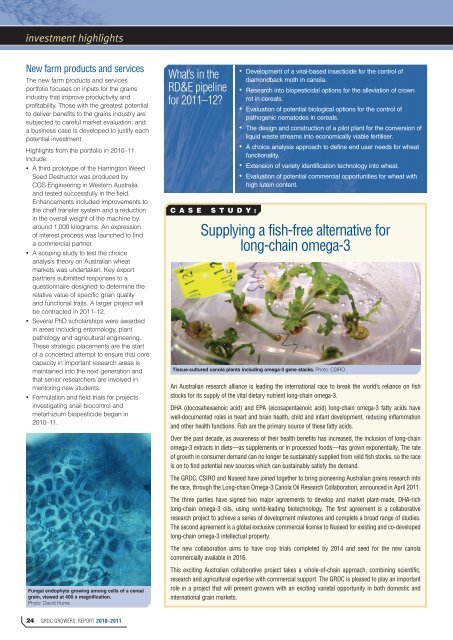grdc growers' report - Grains Research & Development Corporation
grdc growers' report - Grains Research & Development Corporation
grdc growers' report - Grains Research & Development Corporation
Create successful ePaper yourself
Turn your PDF publications into a flip-book with our unique Google optimized e-Paper software.
investment highlights<br />
New farm products and services<br />
The new farm products and services<br />
portfolio focuses on inputs for the grains<br />
industry that improve productivity and<br />
profitability. Those with the greatest potential<br />
to deliver benefits to the grains industry are<br />
subjected to careful market evaluation, and<br />
a business case is developed to justify each<br />
potential investment.<br />
Highlights from the portfolio in 2010–11<br />
include:<br />
• A third prototype of the Harrington Weed<br />
Seed Destructor was produced by<br />
CGS Engineering in Western Australia<br />
and tested successfully in the field.<br />
Enhancements included improvements to<br />
the chaff transfer system and a reduction<br />
in the overall weight of the machine by<br />
around 1,000 kilograms. An expression<br />
of interest process was launched to find<br />
a commercial partner.<br />
• A scoping study to test the choice<br />
analysis theory on Australian wheat<br />
markets was undertaken. Key export<br />
partners submitted responses to a<br />
questionnaire designed to determine the<br />
relative value of specific grain quality<br />
and functional traits. A larger project will<br />
be contracted in 2011–12.<br />
• Several PhD scholarships were awarded<br />
in areas including entomology, plant<br />
pathology and agricultural engineering.<br />
These strategic placements are the start<br />
of a concerted attempt to ensure that core<br />
capacity in important research areas is<br />
maintained into the next generation and<br />
that senior researchers are involved in<br />
mentoring new students.<br />
• Formulation and field trials for projects<br />
investigating snail biocontrol and<br />
metarhizium biopesticide began in<br />
2010–11.<br />
What’s in the<br />
RD&E pipeline<br />
for 2011–12<br />
C A S E S T U D Y :<br />
• <strong>Development</strong> of a viral-based insecticide for the control of<br />
diamondback moth in canola.<br />
• <strong>Research</strong> into biopesticidal options for the alleviation of crown<br />
rot in cereals.<br />
• Evaluation of potential biological options for the control of<br />
pathogenic nematodes in cereals.<br />
• The design and construction of a pilot plant for the conversion of<br />
liquid waste streams into economically viable fertiliser.<br />
• A choice analysis approach to define end user needs for wheat<br />
functionality.<br />
• Extension of variety identification technology into wheat.<br />
• Evaluation of potential commercial opportunities for wheat with<br />
high lutein content.<br />
Supplying a fish-free alternative for<br />
long-chain omega-3<br />
Tissue-cultured canola plants including omega-3 gene stacks. Photo: CSIRO<br />
An Australian research alliance is leading the international race to break the world’s reliance on fish<br />
stocks for its supply of the vital dietary nutrient long-chain omega-3.<br />
DHA (docosahexaenoic acid) and EPA (eicosapentaenoic acid) long-chain omega-3 fatty acids have<br />
well-documented roles in heart and brain health, child and infant development, reducing inflammation<br />
and other health functions. Fish are the primary source of these fatty acids.<br />
Over the past decade, as awareness of their health benefits has increased, the inclusion of long-chain<br />
omega-3 extracts in diets—as supplements or in processed foods—has grown exponentially. The rate<br />
of growth in consumer demand can no longer be sustainably supplied from wild fish stocks, so the race<br />
is on to find potential new sources which can sustainably satisfy the demand.<br />
The GRDC, CSIRO and Nuseed have joined together to bring pioneering Australian grains research into<br />
the race, through the Long-chain Omega-3 Canola Oil <strong>Research</strong> Collaboration, announced in April 2011.<br />
The three parties have signed two major agreements to develop and market plant-made, DHA-rich<br />
long-chain omega-3 oils, using world-leading biotechnology. The first agreement is a collaborative<br />
research project to achieve a series of development milestones and complete a broad range of studies.<br />
The second agreement is a global exclusive commercial license to Nuseed for existing and co-developed<br />
long-chain omega-3 intellectual property.<br />
The new collaboration aims to have crop trials completed by 2014 and seed for the new canola<br />
commercially available in 2016.<br />
Fungal endophyte growing among cells of a cereal<br />
grain, viewed at 400 x magnification.<br />
Photo: David Hume<br />
This exciting Australian collaborative project takes a whole-of-chain approach, combining scientific,<br />
research and agricultural expertise with commercial support. The GRDC is pleased to play an important<br />
role in a project that will present growers with an exciting varietal opportunity in both domestic and<br />
international grain markets.<br />
24 GRDC GROWERS’ REPORT 2010–2011

















